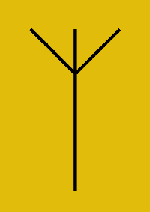This is something I've been meaning to write somewhere for a really long time, ever since my Boston days, where I came across Poetica Vaginal, a quasi-covert science-art project Joe Davis spearheaded in the 1980s.
So now that blogging is offering the opportunity, here it is:
Genesthetics: Molecular Biology and Microbiology in the Arts
Joe Davis, is (or was?) a research affiliate in the Department of Biology at MIT. He is an artist who has done extensive research in molecular biology and bioinformatics for the production of genetic databases and new biological art forms. He has also constructed sculptural installation pieces, working with laser fabrication in plastics, steel, and stone; laser teleoperator systems; and structural welding in mild steel.
Davis himself has altogether different ideas about how science and art can be coaxed or forced together. For seven years he championed a space shuttle experiment that would have shot a 100,000-watt electron gun into the magnetosphere to create the first artificial aurora.
For Poetica Vaginal he recorded the vaginal contractions of ballerinas with the Boston Ballet and other women, then translated them into text, music, phonetic speech and ultimately into radio signals, which were beamed from M.I.T.'s Millstone radar into outer space. The Air Force soon found out about the million-watt Poetica Vaginal broadcast, as Davis calls it, and shut it down. But the 20-minute message was many times longer than the the first deliberate attempt to say hello to extraterrestrial ham radio operators, a string of 1,679 bits that Carl Sagan and Frank Drake beamed from the giant dish in Arecibo, Puerto Rico, 26 years ago. That message, like every engraved plaque and recorded video disk that NASA allowed on the Pioneer and Voyager space probes, made no attempt to convey what aliens would probably be most curious to know about humans: how we reproduce.
In a keynote lecture at the Ars Electronica exhibition, Davis described his most ambitious transgenic artwork yet: putting an image of the Milky Way into a mouse's ear, an idea inspired by a children's story written 30 years ago by a girlfriend. In order to encode such a large amount of binary information in DNA, he spent years figuring out a general method for archiving computer databases in biological form, a "supercode" that guarantees the infogene will be biochemically stable and yet prevents the host from translating it into protein.
I'm gonna close with a really sad fact I read on Scientific American, that Davis still remains utterly dependent on donations of equipment and expertise from scientists. Because he sells his conventional sculptures to friends at cost and cannot sell his transgenic art at all, even now Davis flirts on the verge of homelessness, with no fixed address. In the fall of 2000 he returned from Europe to find an eviction notice on his door. Much of what he rescued from the sheriff's auction was jammed into a decrepit Volvo station wagon that he obtained in trade for a self-assembling clock. Davis kept Mississippi plates on the car, even though he hasn't lived there in decades, to squeeze through a loophole that exempted it from property taxes. This was published way back in 2001, and I would be really curious to learn of his recent whereabouts...in hope that he is doing well.









